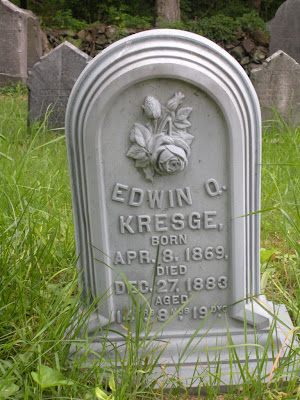 |
| Stoddartville Cemetery, Stoddartville, PA |
A few weeks ago, my boneyard buddy Poppa Schane and I were in Susquehanna County, hunting cemeteries that we haven’t yet discovered. We found West Lenox Baptist Cemetery in West Lenox, PA, in Susquehanna County, and it was a small cemetery across from the church, with maybe two hundred burials. Even though it was small, it contained three zinc monuments. These monuments were made by the Monumental Bronze Company, located in Bridgeport, CT. The company made zinc memorials from about 1875 to 1912, and sold them through a network of salesmen throughout the country. For a more in-depth history, please see my blog called “Heavy Metal Memories”: http://callmetaphy.blogspot.com/2011/09/heavy-metal-memories.html.
Most late-Victorian cemeteries have at least one zinc marker in them, but my father remarked that we had found many cemeteries in the northernmost counties in Pennsylvania that had at least three zincs; and some had as many as ten. Most of Susquehanna, northern Lackawanna and Wyoming Counties are rural as well and not overly populated. Even cemeteries in nearby Scranton and Wilkes Barre---cities that were major urban industrial centers at the time that Monumental Bronze Company was in business---have only a handful of zinc monuments in them. So why do those northern counties have such a disproportionate number of markers of zinc?
Well, as I mentioned, the Monumental Bronze Company sold its wares through a network of salesmen, who had catalogues to show to prospective buyers. And in many cemeteries where zincs are plentiful, a simple reading of the names usually illuminates the relationships between the deceased, and one can suppose a salesman used family connections to make his commission. But that doesn’t fully explain why zincs are so proliferate in northern Pennsylvania. A look at a map could help:
Bridgeport, CT, is to the southeast of the northern counties of Pennsylvania, with New York in between. And for more than 150 years, that part of Pennsylvania was a bone of contention between two groups of colonists. In the 1600’s, King Charles II seemed to make a bookkeeping error and granted the territory that we know as northern Pennsylvania to both William Penn and to the originators of the colony of Connecticut. These overlapping land claims resulted in the Pennamite-Yankee Wars as both colonies fought for control of the Wyoming Valley and the northern branch of the Susquehanna River. Both parties also purchased the same lands from the Native Americans in the mid-1700’s (perhaps the Indians had the same bad accountant as King Charles??), but the Connecticut “Yankees” sent settlers to the territory first in 1754. The Pennamites (Pennsylvanians) followed soon after, and armed conflict broke out in 1769-70. King George III confirmed Connecticut’s claim in 1771, but the Pennamites refused to accept this, and conflict broke out again in 1775. Only a handful of the fighting settlers actually died in these two “wars,” but the territorial dispute continued.
In 1782, the Continental Congress overturned the ruling of the king they had just bested and instead, confirmed the Pennsylvania claim to the land. Another conflict erupted then when Pennsylvania tried to oust the Connecticut settlers, but Connecticut and Vermont men came into the territory to support the Yankee settlers, resulting in another stalemate. Finally, in 1799, through laws passed by the Pennsylvania Legislature, the lands became part of Pennsylvania, but the Yankee settlers from Connecticut became Pennsylvanians with legal claims to the lands they had settled.
Many of the families that settled in the northern counties of Pennsylvania in the late 1700s and 1800s emigrated from Connecticut, and it would stand to reason that they would maintain their ties with family left behind in that state. Perhaps when the Monumental Bronze Company needed a sales force, they started locally and then those salesmen spread the word west to their kin in northern Pennsylvania. That is my theory about why the northern Pennsylvania counties have so many zinc monuments in small rural cemeteries. Regardless of the reason, enjoy some photographs of the wonderful zinc monuments that have stood the test of time. Contact me at tschane2@verizon.net, thanks.
 |
| West Lenox Baptist Cemetery, West Lenox, PA |
 |
| West Lenox Baptist Cemetery, West Lenox, PA |
 |
| East Bangor Cemetery, East Bangor, PA |
 |
| Doylestown Cemetery, Doylestown, PA |
 |
| Tennent Presbyterian Cemetery, Tennent, NJ |
 |
| Fairview Cemetery, Middletown, NJ |
 |
| Easton Cemetery, Easton, PA |
 |
| My boneyard buddy himself, Evergreen Cemetery, Jim Thorpe, PA |
 |
| Fairview Cemetery, Middletown, NJ |
 |
| Jefferson Presbyterian Cemetery, Jeffersonville, PA |
 |
| Mauch Chunk Cemetery, Jim Thorpe, PA |
 |
| Mount Pleasant Cemetery, Newark, NJ |
 |
| Effort Cemetery, Effort, PA |
 |
| Lemon Cemetery, Lemon, PA |
 |
| Easton Cemetery, Easton, PA |
 |
| Thompson Cemetery, Thompson, PA |
 |
| Dunmore Cemetery, Dunmore, PA |
 |
| Flicksville UCC Cemetery, Flicksville, PA |
 |
| Gnaden Huetten Cemetery, Lehighton, PA |
 |
| Greenwood Cemetery, Howertown, PA |
 |
| Hollenback Cemetery, Wilkes Barre, PA |
 |
| Hollisterville Cemetery, Hollisterville, PA |
 |
| Mount Moriah Cemetery, Kimble, PA |
 |
| Newfoundland Moravian Cemetery, Newfoundland, PA |
 |
| St. Mark's Lutheran Cemetery, Appenzell, PA |
 |
| St. Peter's Evangelical Lutheran Cemetery, Lafayette Hill, PA |
 |
| Stoddartville Cemetery, Stoddartville, PA |



1 comment:
I think your zinc glut theory is well-founded. It prob was Inspired by the book How to Win gravesite contracts and influence people. Seriously though, your expertise in translating the meanings of our predecessor final messages amaze me.
Post a Comment